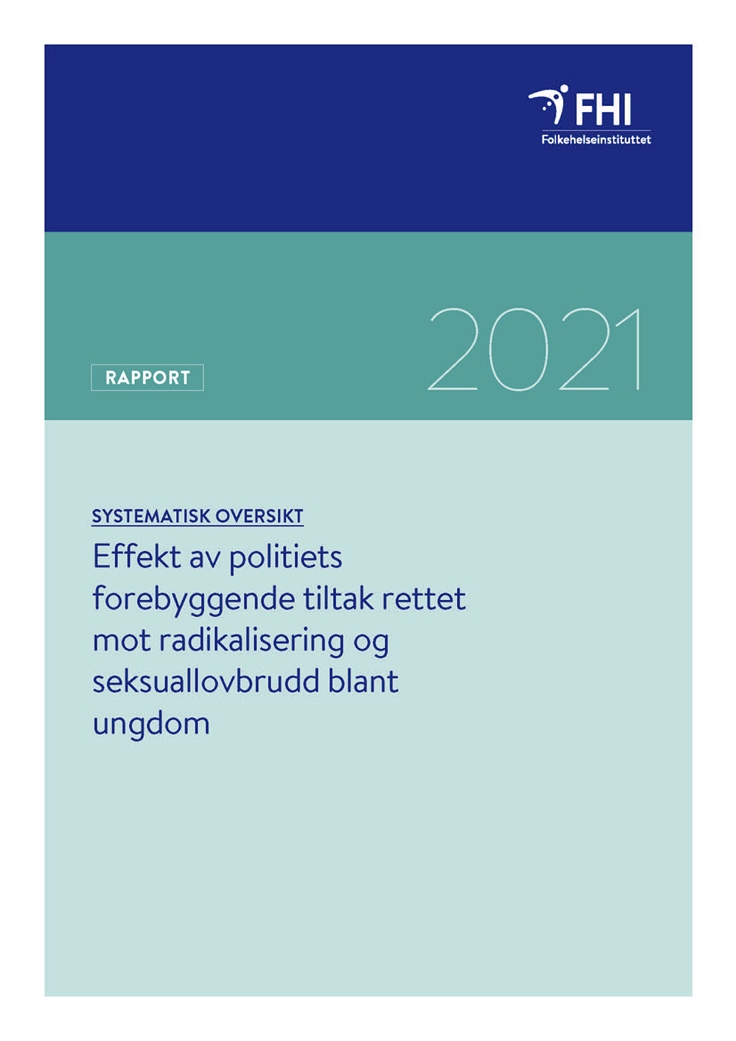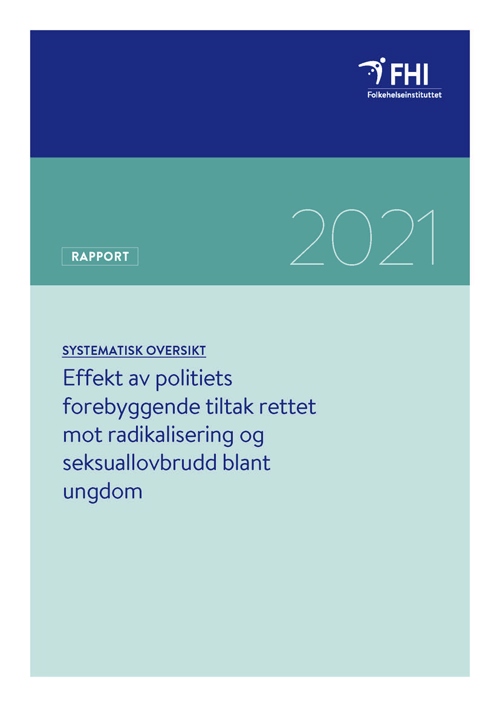Effect of prevention work by the police targeting radicalisation and sexual offences among youth: a systematic review
Systematic review
|Published
We were commissioned by the National Police Directorate (POD) to conduct a systematic re-view on the effect of crime prevention strategies targeting sexual offences and radicalisation among young people.
Key message
We were commissioned by the National Police Directorate (POD) to conduct a systematic review on the effect of crime prevention strategies targeting sexual offences and radicalisation among young people. The review aimed to summarise and analyse studies on the effect of crime prevention work by the police to prevent sexual offences and radicalisation among youth and young adults up to the age of 24. The goal of conducting this review was to add to and strengthen the evidence on crime prevention, which is one of the main strategies of the Norwegian police.
We searched for controlled studies on the effects of crime prevention interventions targeting youth, from Nordic countries or other countries in Europe. The studies had to be published in 2000 or more recently. We conducted a comprehensive search and screened more than 12 000 studies. We identified no studies that met the inclusion criteria of our systematic review. Our main finding is therefore:
- There is a lack of studies on the effects of prevention work conducted by the police to prevent sexual offences and radicalisation among youth.
There are likely many complex reasons for the shortage of this kind of research, and several factors need to be accounted for in the planning of future studies. There is a need for controlled studies on the effects of the police’s prevention work related to sexual offences and radicalisation among youth. Future research should specify which preventive effects are sought and be conscious of follow-up.
Summary
Introduction
Young people between 18 and 20 years comprise the largest portion of people charged with misdemeanours in Norway today. Preventing youth crime is thus imperative, and in Handlingsplan for forebygging av kriminalitet (2013–2016) a broad approach to crime prevention is supported, with a particular focus on child and juvenile delinquency. In general, there has been a reduction in the numbers in penalised youth in later years.
Sexual offence is the only category of misdemeanours that has not seen a general reduction in the numbers of penalised youth between 2007 and 2017.
Radicalisation, violent extremism, and terrorism receive a lot of attention, and create fear among the public. Despite this, the threat of terror in Norway is considered to be low. According to the Norwegian Police Security Service’s (PST) threat assessment, it is possible that persons or groups inspired by Islamic extremism may attempt to perform terror acts. The number of people newly radicalised to such groups is expected to remain low. The threat from right-wing extremists, however, has increased, and it is now considered possible that violent actions may be performed from such individuals or groupings. The number of people in Norway who express support for right-wing extremist terror actions and terrorism has also increased. It is difficult to find exact numbers of how many who are already radicalised or in danger of being radicalised.
The present research concerns the planned and systematic work the police perform, alone or in collaboration with others, to reduce the risk of crime. The main research question was: What is the effect of different police interventions to prevent sexual offences and radicalisation among youth and young adults (up to 24 years old)?
Method
We conducted a systematic review according to the method handbook for the Division for Health Services, Norwegian Institute of Public Health. From March to May 2020 we conducted a comprehensive search for studies. We searched in electronic literature databases and in sources for grey literature. Grey literature is research that has not been published in traditional or formal commercial publication channels. We searched for studies published 2000 and more recently.
Two researchers independently screened all references identified through the searches; first by title and abstract, and subsequently all relevant full-texts. All studies were screened according to the inclusion criteria.
The inclusion criteria were:
P (population): Youth and young people up to and including 24 years old. We wanted to look at groups/individuals the police has the means to work towards, i.e. who are not in psychiatric treatment. We were to include prevention work targeting individuals already charged with misdemeanours (in addition to individuals who have not conducted any misdemeanours).
I (intervention): Interventions that are a part of prevention work done by the police, meant to prevent sexual offences and radicalisation. Interventions could be on three levels: Universal, selected or indicated.
C (comparison): No intervention: standardised interventions that do not involve prevention; or other types of prevention (e.g. interventions initiated and conducted by others/other institutions than the police).
O (outcome): (New) sexual offences, radicalisation, and changes in attitudes, e.g. decline in registered misdemeanours/ radicalisations cases, decline in self-reported risk, and decline in number of reports of concern.
Design: Systematic review of studies of effect.
Primary research: Randomised controlled trials, non-randomised controlled trials, controlled before and after trials, prospective controlled studies, time-series designs with at least three measuring points before and after the trial.
Follow up: No limit.
Language: We were to include trials in any language.
Context: Prioritised as follows:
1: Nordic countries
(Norway, Sweden, Denmark, Finland and Iceland),
2: Holland and Great Britain,
3: Europe.
Year: Prioritised as follows:
1: Published year 2000 and later.
2: Published year 1980 and later.
Results
We read the titles/abstracts of 12 404 references, of which 1,157 were identified through grey literature searches. Of these, 31 studies were at this stage considered as potentially relevant against the inclusion criteria and thus assessed in full-text. None of these 31 studies met the inclusion criteria.
Discussion and conclusion
There is a lack of research on the effect of prevention work conducted by the police, targeting sexual offences and radicalisation among youth. The reasons for this are probably complex, and in future research there are several factors that should to be taken into account. Future studies on the effect of crime prevention should specify what effects are sought. There is also a need of being conscious of follow-up, and in what time perspective the effect of preventive measures are relevant.

